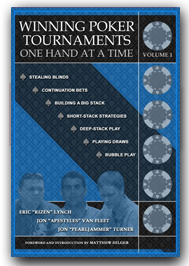
My Two Minute Recommendation: Winning Poker Tournaments One Hand at a Time scores a 9/10. Three top players discuss nearly 200 real hands and address dozens of common mistakes that even experienced no-limit hold ’em tournament players make. Read Harrington on Hold ‘Em first for a theoretical foundation, but read this book next to see the ideas in action.
I am one of those cash game players who likes to deride tournament specialists as uncreative “tourney donks” whose poker skill is limited to an encyclopedic knowledge of pre-flop shoving ranges. I half-expected that that would be my reaction to Winning Poker Tournaments One Hand at a Time by Jon “Pearljammer” Turner, Eric “Rizen” Lynch, and Jon “Apestyles” Van Fleet.
I must say that I was pleasantly surprised.
These guys are among the best in the world at beating online tournaments full of weak players. There’s a temptation to look down my nose and say they don’t understand concepts like 3rd-level thinking or balancing, but honestly those just aren’t particularly important skills in these events. I wouldn’t stake these guys in a high rollers’ event or hire them to teach me cash game poker, but they beat the snot out of large-field poker tournaments, and in this book they teach you how to do the same in remarkably clear fashion.
This isn’t a beginner’s book, and it won’t do much for anyone with the postflop skills to beat 100NL, but for the tens of thousands of players in between, Winning Poker Tournaments One Hand at a Time is an invaluable resource. I would say that it’s required reading as soon as you finish the Harrington on Hold ‘Em series, and even if you consider yourself an advanced tournament player, do yourself a favor and read this book just in case. It addresses so many of the mistakes that I most commonly see among intermediate tournament players that you’re very likely to learn a thing or two.
Chief among these mistakes is an inability to read hands and make disciplined folds. Although these players’ hand-reading skills are not uniformly fantastic, they provide a very solid introduction to the concept, and they are particularly adept at interpreting betting lines commonly employed by weak players. Granted beating weak players is easy, but there’s a difference between beating them and maximizing your advantage against them. This book is full of examples that clearly and concisely illustrate the reasoning behind some seemingly tough folds and surprising bluffs…. Read the full review in the book reviews archive

Andrew –
Glad you enjoyed the book – here’s my take on it, from a couple years back:
http://spritpot.blogspot.com/2008/10/book-review-winning-poker-tournaments.html
-bruechips
Very nice, thanks!
Andrew, your reviews are always good and this was no exception. Allow me to insert a novice question about balance. It seems balancing one’s range is vital to cash games, and quite important for large, deep stack tournaments. I don’t see the value in it for many small online tournaments or SNGs. Do you have any input on where the line should be drawn for tournament size or stack level regarding the importance of balance?
Thanks as always for your time and effort.
Russ
Thanks, pie. Balancing is important against good players and in situations where you literally have no educated guess as to what the best exploitive play might be. Those could arise in any type of game. But balance is no more important against weak cash game players than it is against weak tournament players. Exploitable is better as long as you know what you’re exploiting and have reason to think your opponent(s) won’t be able to take advantage of it.
If your opponent is truly unknown, like you have no idea whether he’s good or not or what he’s capable of or how he’ll respond, then you also should play a relatively balanced strategy. But even against unknowns I’m usually comfortable making a lot of assumptions, ie that they won’t 3-bet especially light, won’t multi-barrel bluff very often, won’t make thin value bets, won’t turn hands into bluffs, etc. Those assumptions are right far more often than they’re wrong, and they are plenty of basis for formulating an exploitive, unbalanced game plan that is usually more profitable than balanced play.
This is essentially the strategy that you’ll find in this book as well.